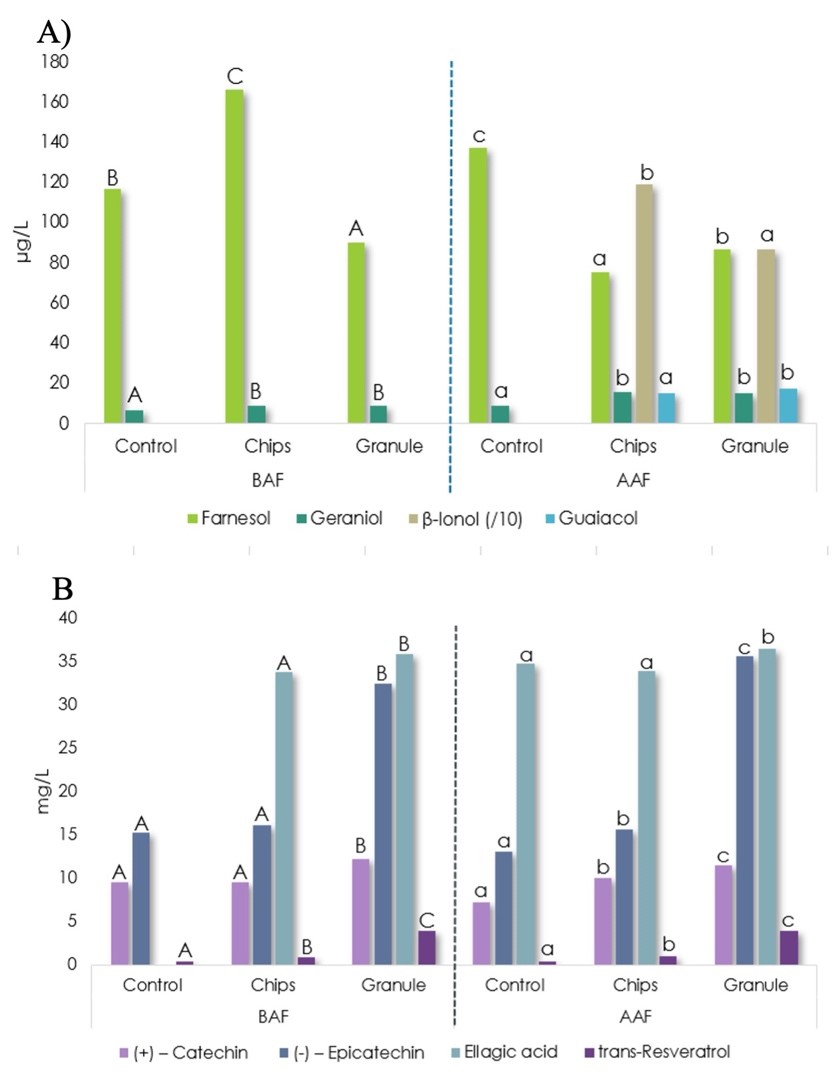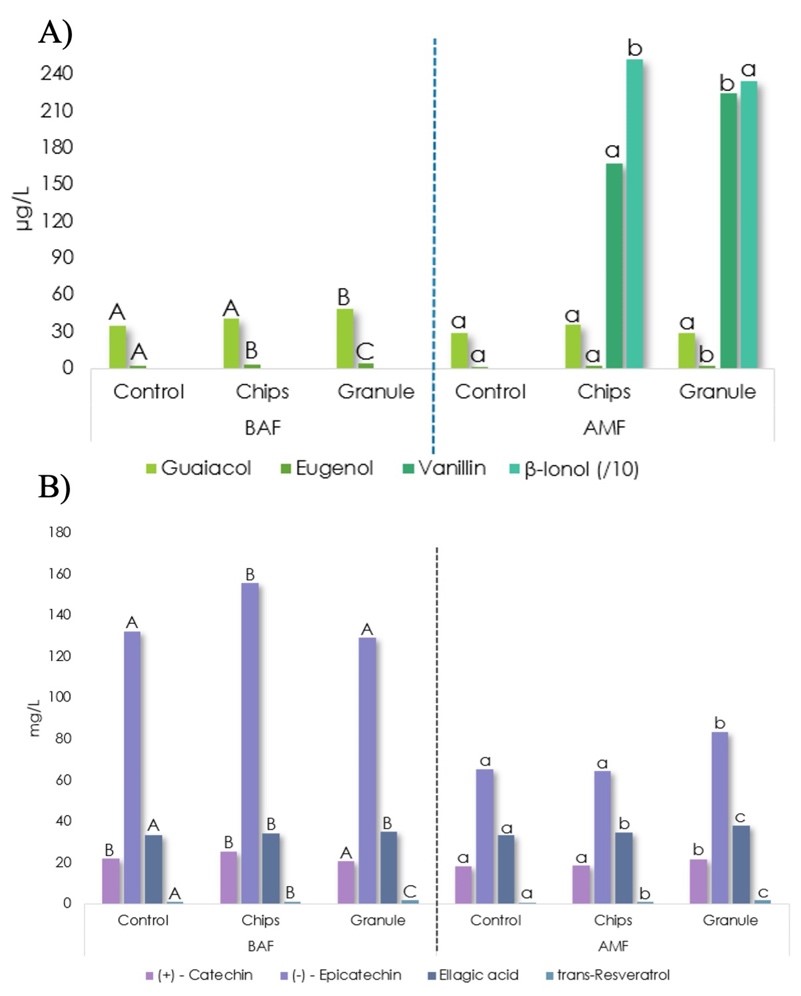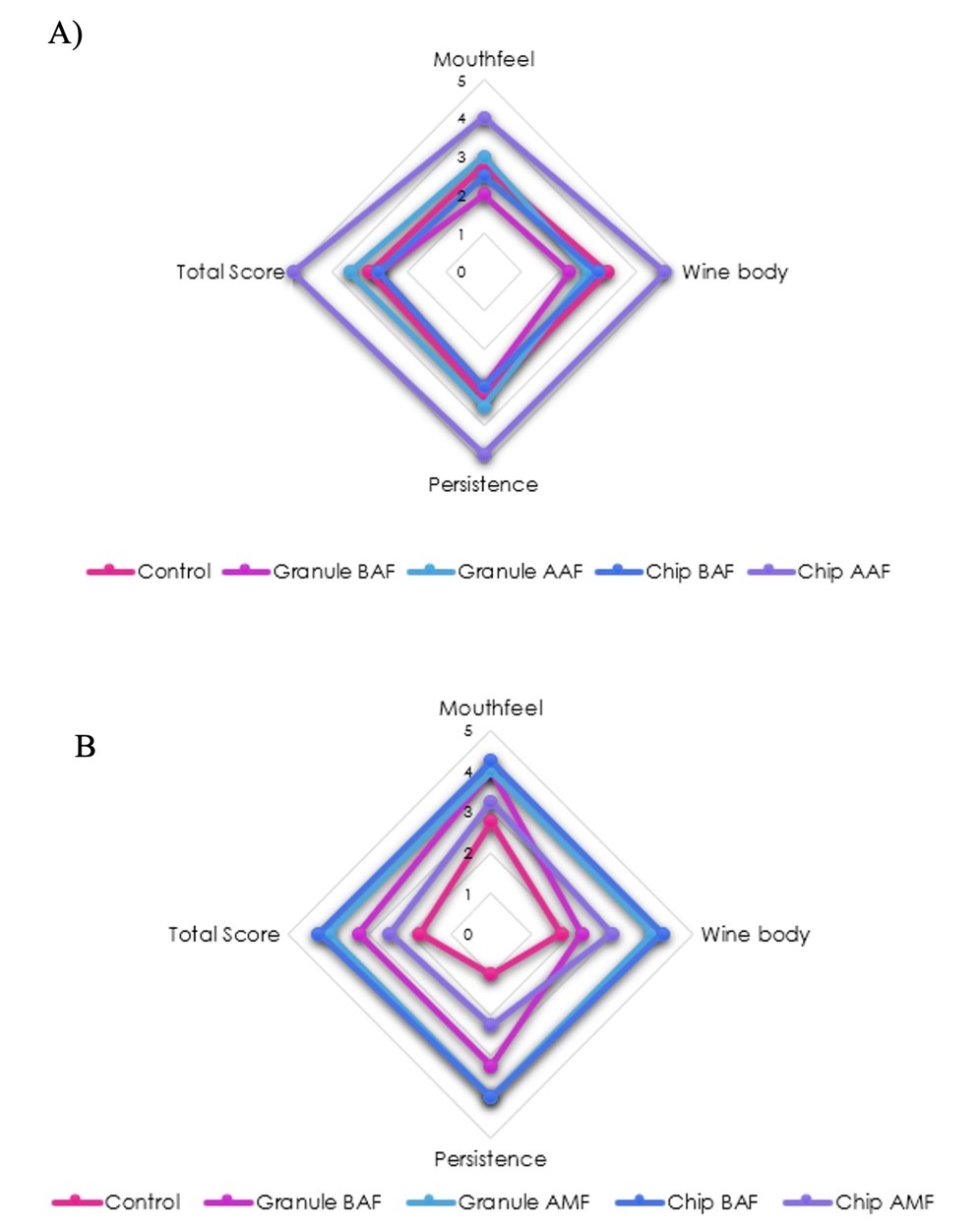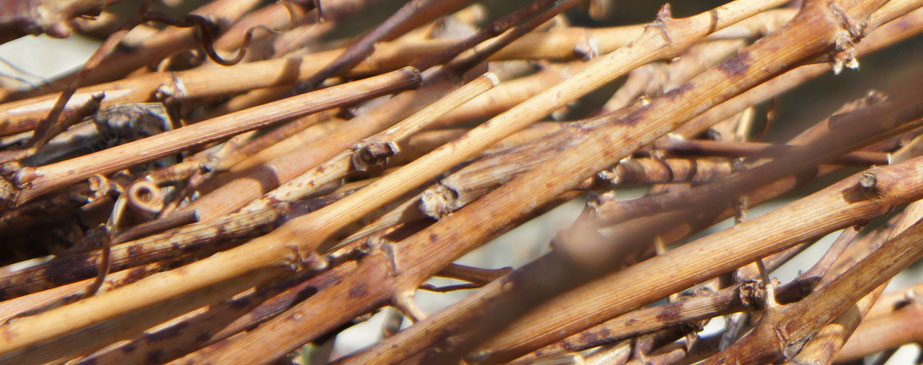Toasted vine shoots from two varieties, Airén and Cencibel (Tempranillo), were used in two different formats – granules and chips – and added to wine at different winemaking stages for the research. The results (republished below with permission of the authors) show that such additives can improve the quality of wine “by enhancing their varietal and woody aromas”.
Although Airén is a neutral grape variety from an aromatic point of view, this research showed “a significant increment in volatile compounds with floral and fruity notes” when the wine was made in contact with vine shoots. The researchers concluded: “The varietal character of the wine is thereby improved by using the vine’s own resources.”
For Cencibel, vine shoots gave the wines “red and forest fruit” aromas, toasted wood notes, and improved mouthfeel.
As wines made with toasted vine shoots scored better than the control wines in the taste tests, the researchers suggest “there is potential for this practice to be developed as a new and innovative alternative to managing vineyard waste – in this case vine shoots – and thus link viticulture and oenology in a new concept of circular viticulture”.
Here's the technical article, published by IVES Technical Reviews, property of the International Viticulture and Enology Society.
Modulating a wine profile via an innovative use of vine shoots
The chemical composition of vine shoots is characterised by oenological compounds with high added value, which could contribute to the sensory profile of wines. In this study, toasted vine shoots from two varieties were used in two different formats, granules and chips, and added to wine at different winemaking stages. The results show that oenological additives in the form of vine shoots can modulate the chemical composition of wines, and therefore their quality, by enhancing their varietal and woody aromas; thus connecting viticulture and oenology and creating a new concept: circular viticulture.Study context
Over the years, the growing concern for the environment has generated a new “green” revolution in viticulture, which has unquestionably led the sector towards sustainable viticulture. Therefore, the search for new uses for vine shoots is of great interest among researchers.The chemical composition of toasted vine shoots is similar to that of oak wood, giving us the possibility to direct our research towards a circular viticulture by using them in oenology. Based on this, a preliminary study was carried out on the transfer of vine-shoot compounds to model wine solutions taking into account their format, dosage and maceration time.
Trials
The aim of this work was to evaluate the use of vine shoots as an oenological additive in real wines by analysing their influence on the final chemical profile of red and white wines. In order to do this two Vitis vinifera vine-shoot cultivars, Airén and Cencibel, were toasted, prepared in two formats, chips and granule, and were added into their corresponding wines at a dose of 12g/L before alcoholic fermentation (BAF), after alcoholic fermentation in Airén wines (AAF) and after malolactic fermentation in Cencibel wines (AMF). The oenological parameters and total polyphenols index (TPI) were analysed by FT-IR, the low molecular weight phenolic compounds (LMWPC) by HPLC-DAD and the volatile compounds by SBSE-GC-MS. Finally, a sensory analysis was carried out on the visual, olfactory and taste phases, in order to evaluate the quality of the wines by associating a lower or higher score with a lower or higher perception respectively.Effect of Airén vine-shoot addition on Airén white wines
In the Airén wines, no significant differences were found in the main oenological parameters. However, significant differences were found when comparing the wines in contact with vine shoots, which had a higher total polyphenols index (TPI) value. Regarding the volatile compounds (Figure 1A), the highest increment was observed in β-ionol, a precursor of β-ionone and a terpenoid known and appreciated for its violet floral aroma. This compound was only detected in AAF wines produced in contact with vine-shoot granules, and not in the control wines. Farnesol was the second most abundant terpenoid, but it only increased with respect to the control wine when alcoholic fermentation took place in the presence of chips (BAF). Geraniol, a terpenoid which also has floral notes, significantly increased when the wines were in contact with vine shoots regardless of the winemaking step. Regarding wood aromas, guaiacol was found in AAF wines when chips or granules were used, with values higher than the odour threshold (9.5 μg/L) and thereby contributing “toasted” notes to the wine sensory profile.The main contribution in terms of low molecular weight phenolic compounds (LMWPC) is shown in Figure 1B. In the case of BAF wines, only (+)-catechin and (−)-epicatechin concentrations were significantly different with respect to the control wine when granules were used. As regards phenolic acids, the contribution of vine shoots to ellagic acid content was clear in BAF wines, with concentrations close to 33mg/L, and it was not detected in the control wine. Finally, the contribution of vine shoots to trans-resveratrol content was expected, with the most significant increase occurring when granules were used (3.90mg/L), which was four-fold their respective control wines and closer to levels obtained for the red wines.
Figure 1 (below): Main compounds of Airén wines influenced by the use of Airén vine shoots as oenological additives: A) Volatile compounds B) Low molecular weight phenolic compounds. Capital letters indicate significant differences between compounds in wines treated with vine shoots before alcoholic fermentations (BAF) and lower case letters indicate significant differences between compounds in wines treated with vine shoots after alcoholic fermentations (AAF) according to the Tukey test (p < 0.05).

Effect of Cencibel vine-shoot addition on Cencibel red wines
The addition of Cencibel vine shoots to red wine did not significantly modify its oenological parameters, TPI and total tannin. The main effects on wine volatile and phenolic compounds are shown in Figure 2 (below). Similar to Airén wines, only some compounds from the volatile phenols and terpenoids families were influenced by the treatments (Figure 2A). In BAF wines, fermented in the presence of granule vine shoots (BAF), guaiacol was the most abundant compound. In both wines, its content was significantly higher than its OT (odour threshold; previously indicated), but lower than the threshold above which it is considered a defect. Therefore, the “toasted” notes of the woody aroma profile should be perceived as being pleasant at the sensory level. Eugenol increased in all the wines, being higher in content when vine shoots were added at the BAF stage rather than at the AMF stage. The vanillin content in AMF wines were three to four times higher than its OT (60 μg/L), being comparable to the levels reported when the oak barrels were tested. The vanillin contribution to the aroma of the AMF wines was noticeable in the tasting performed. Regarding terpenoids, AMF wines showed a significant increment in β-ionol.Among the LMWPC identified in Cencibel wines (Figure 2B), the most abundant flavanols were (+)-catechin and (−)-epicatechin. However, total flavanol content only significantly increased in BAF wines when using chips, due to the higher concentration of (−)-epicatechin. Regarding phenolic acids, the quantity of ellagic acid released to the wines made with vine shoots was significant, especially in case of AMF wines with granules. Finally, the contribution in terms of trans-resveratrol was clear, as its content increased when granules were used regardless of when it was added.
Figure 2 (below): Main compounds of Cencibel wines influenced by the use of Cencibel vine shoots as oenological additives: A) Volatile compounds, and B) Low molecular weight phenolic compounds. Capital letters indicate significant differences between compounds in wines treated with vine shoots before alcoholic fermentations (BAF) and lower case letters indicate significant differences between compounds in wines treated with vine shoots after malolactic fermentation (AMF) according to the Tukey test (p < 0.05).

Sensory analysis
In Airén wines, the tasters identified a higher colour intensity in wines produced with vine-shoot granules. Regarding the olfactory phase, a pleasant ripe fruit odour was perceived in all the vine-shoot wines. Moreover, toasted wood notes were identified, especially in granule BAF wines. Finally, in the taste phase (Figure 3A), AAF wines made in the presence of chips received the best scores, being described as having a blended, soft and pleasant tannin with volume and good acidity.In Cencibel wines, a violet tonality was observed in the wines produced with chips and a maroon tonality in the other wines. In the olfactory phase, red and forest fruits were detected in all the wines made with vine shoots, but not in the control. Moreover, only toasted wood notes were detected in BAF wines whatever the format used. Finally, in the taste phase (Figure 3B), AMF wines made with granules and BAF wines with chips received the best scores. The former showed a good mouthfeel and persistence and the latter a sweet mouthfeel, with a soft tannin and a good structure.
Figure 3 (below): Sensory analysis of Airén (A) and Cencibel (B) wines made with vine shoots as an oenological additive. Control: wines made without vine shoots. BAF: wines treated with vine shoots before alcoholic fermentations. AAF and AMF: wines treated with vine shoots after alcoholic and malolactic fermentations.

Significance and impact of the study
This study confirms that the addition of toasted vine shoots to wines can modulate their chemical composition and sensory perception when compared with their respective control wines. It is important to note that, although Airén is a “neutral” grape variety from an aromatic point of view, a significant increment in volatile compounds with floral and fruity notes occurred when wine was made in contact with vine shoots; the varietal character of the wine is thereby improved by using the vine’s own resources.For Cencibel wines, similar behaviour was observed in terms of volatile compounds. Therefore, although other conditions should be tested, there is potential for this practice to be developed as a new and innovative alternative to managing vineyard waste – in this case vine shoots – and thus link viticulture and oenology in a new concept of circular viticulture.
Sourced from the research article ‘Winemaking with vine shoots. Modulating the composition of wines by using their own resources’
Researchers: Cristina Cebrián-Tarancón, Rosario Sánchez-Gómez, Maria Joao Cabrita, Raquel Garcia, Amaya Zalacain, Gonzalo L. Alonso, M. Rosario Salinas













.png)






